Cardiovascular Disease Increases After COVID-19 Infection, 7 Tips for a Healthy Heart
On Jan. 12, Lisa Marie Presley, daughter of American rock star and the “King of Rock ‘n’ Roll,” Elvis Presley, died of cardiac arrest—once again arousing public attention to heart disease. Shu Rong, a senior British traditional Chinese medicine (TCM) physician, reminds us of the need to be fully aware of the five distress signals of the heart. Usually, heart problems are not taken seriously until after the onset of the disease. Shu shared the cases of two patients who initially came to see him for other diseases. One patient came to see him because was suffering from pain in his leg. Shu found that the man’s pulse reflected he was suffering from blood stagnation, and recommended he get a thorough cardiac work up. After the hospital examination, it was found that he had three main blood vessels blocked, and he needed immediate surgical intervention. Another patient also came for other reasons and Shu found that the heart qi of the man was very weak, and showed that a heart problem was more serious than other symptoms. However, the patient didn’t take it seriously at the time. One day, five years later, the patient suddenly passed out with numbness in his hands and arms. After emergency first aid, he was found to have a blocked blood vessel. At that time, the patient was unwilling to undergo surgery, and remembered that Shu had reminded him of his heart problem five years ago—so he returned to Shu for medical care. After several months of treatment, the patient underwent another cardiac work up and was told that the heart condition was better, and no surgery was needed. Shu said that the heart sends out many warning signs—usually TCM can detect some of those signs early—but patients also need to be aware of them. 5 Distress Signals Sent by the Heart What warning signals does the heart send out? Shu pointed out the five distress signals: 1. The Tongue TCM believes that the tongue is the epitome of the whole body, and each part of the tongue corresponds to a different viscera, or cavity of the body. The tip of the tongue represents the heart—any red spot found at the tip of the tongue indicates that there is a problem with the heart. When the blood circulation is poor, brown thorns appear on the tip of it, which indicates that the blood supply to the myocardium is poor resulting in lack of oxygen. When the myocardium is congested, the signal is shown by “ecchymosis” thorns appearing on the tip of the tongue. From an anatomical point of view, the tongue is the organ with the most micro vessels in the human body, thus it is an area where we can easily see signs of early cardiovascular lesions. (The Epoch Times) 2. The Earlobes Shu said that the deep groove on the earlobe, which is inclined at an angle of 45 degrees, is called “coronary crease,” also known as the diagonal earlobe crease. It was first proposed (called the Frank’s sign) by Sanders T. Frank, an American, in the 1970s. He observed that the coronary crease on the earlobe is related to coronary artery disease (myocardial infarction, ischemic heart disease), and later studies showed that it is also related to peripheral vascular disease and cerebrovascular disease. (The Epoch Times) (The Epoch Times) 3. The Heart Zone Above the Ear If the heart zone (see illustration below) on the ear is sunken or turns dull, or there is a feeling of sharp pain like being pierced by a needle when pressed, it is a warning sign of a heart problem. (The Epoch Times) 4. The Face TCM believes that the face represents the heart. And when there is an abnormally dark red or dull face it indicates a serious heart problem. It is especially serious when the dark red color appears on the cheekbones belonging to the small intestine meridian. In this case, in addition to stagnation of qi and blood, it also means that the heart is beating too frequently, and there is chest pain, shortness of breath, and even heart failure in severe cases. (The Epoch Times) 5. Feet Edema Heart failure will cause the failure of blood to return normally, and from the well-known physical principle that “fluid will follow downward” by nature, symptoms such as edema are likely to appear on the insteps, ankles, and calves. Risk of Cardiovascular Disease Increases After COVID-19 Infection After the outbreak of the COVID-19 pandemic, heart rate increase as an after-effect of the pandemic has been confirmed by the medical profession and is called “post-COVID-19 tachycardia syndrome.” Liu Zhongping, director of Taiwan Yupin Clinic and a cardiologist, said frankly in a Facebook post, that he saw more than 20 patients with accelerated heart rate after being diagnosed with COVID-19 in just one week. Some scientists speculate that infection with COVID-19 induces the body to produce more autoimmune antibodies, and at the same time activates the receptors of the sympathetic nerves, which will lead to an imbalance of the autonomic nerves, and tachycardia. A study published in the journal

On Jan. 12, Lisa Marie Presley, daughter of American rock star and the “King of Rock ‘n’ Roll,” Elvis Presley, died of cardiac arrest—once again arousing public attention to heart disease. Shu Rong, a senior British traditional Chinese medicine (TCM) physician, reminds us of the need to be fully aware of the five distress signals of the heart.
Usually, heart problems are not taken seriously until after the onset of the disease. Shu shared the cases of two patients who initially came to see him for other diseases.
One patient came to see him because was suffering from pain in his leg. Shu found that the man’s pulse reflected he was suffering from blood stagnation, and recommended he get a thorough cardiac work up. After the hospital examination, it was found that he had three main blood vessels blocked, and he needed immediate surgical intervention.
Another patient also came for other reasons and Shu found that the heart qi of the man was very weak, and showed that a heart problem was more serious than other symptoms. However, the patient didn’t take it seriously at the time. One day, five years later, the patient suddenly passed out with numbness in his hands and arms.
After emergency first aid, he was found to have a blocked blood vessel. At that time, the patient was unwilling to undergo surgery, and remembered that Shu had reminded him of his heart problem five years ago—so he returned to Shu for medical care. After several months of treatment, the patient underwent another cardiac work up and was told that the heart condition was better, and no surgery was needed.
Shu said that the heart sends out many warning signs—usually TCM can detect some of those signs early—but patients also need to be aware of them.
5 Distress Signals Sent by the Heart
What warning signals does the heart send out? Shu pointed out the five distress signals:
1. The Tongue
TCM believes that the tongue is the epitome of the whole body, and each part of the tongue corresponds to a different viscera, or cavity of the body.
The tip of the tongue represents the heart—any red spot found at the tip of the tongue indicates that there is a problem with the heart. When the blood circulation is poor, brown thorns appear on the tip of it, which indicates that the blood supply to the myocardium is poor resulting in lack of oxygen.
When the myocardium is congested, the signal is shown by “ecchymosis” thorns appearing on the tip of the tongue. From an anatomical point of view, the tongue is the organ with the most micro vessels in the human body, thus it is an area where we can easily see signs of early cardiovascular lesions.
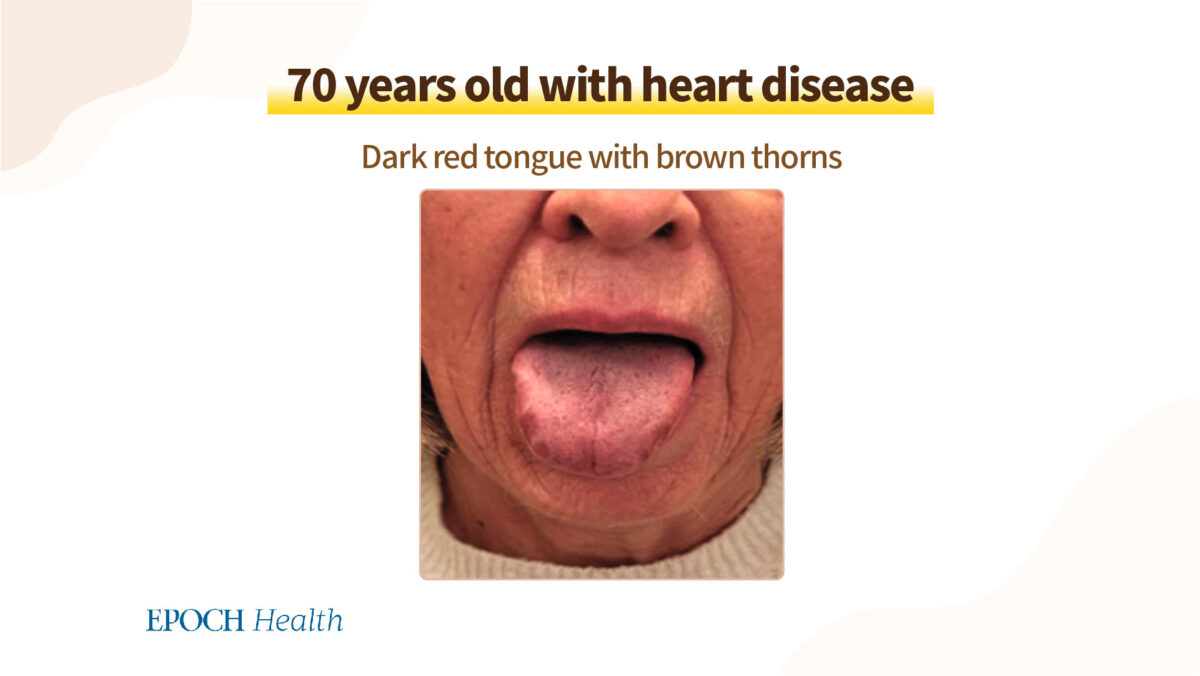
2. The Earlobes
Shu said that the deep groove on the earlobe, which is inclined at an angle of 45 degrees, is called “coronary crease,” also known as the diagonal earlobe crease. It was first proposed (called the Frank’s sign) by Sanders T. Frank, an American, in the 1970s. He observed that the coronary crease on the earlobe is related to coronary artery disease (myocardial infarction, ischemic heart disease), and later studies showed that it is also related to peripheral vascular disease and cerebrovascular disease.
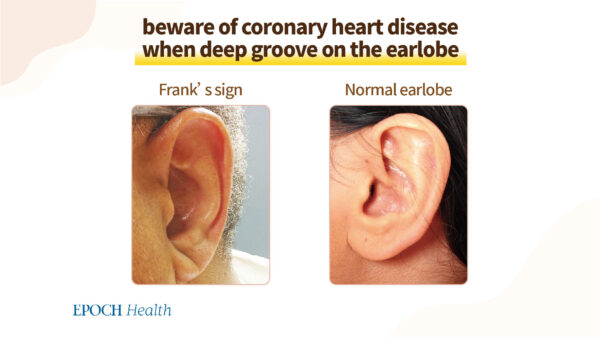
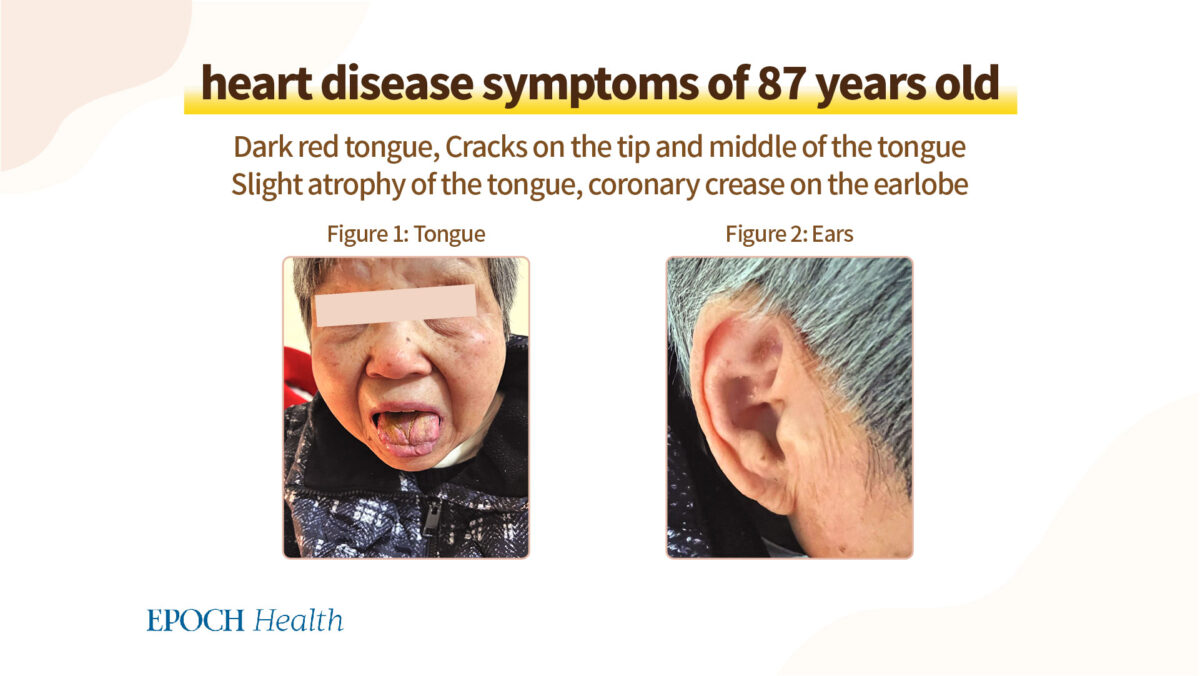
3. The Heart Zone Above the Ear
If the heart zone (see illustration below) on the ear is sunken or turns dull, or there is a feeling of sharp pain like being pierced by a needle when pressed, it is a warning sign of a heart problem.
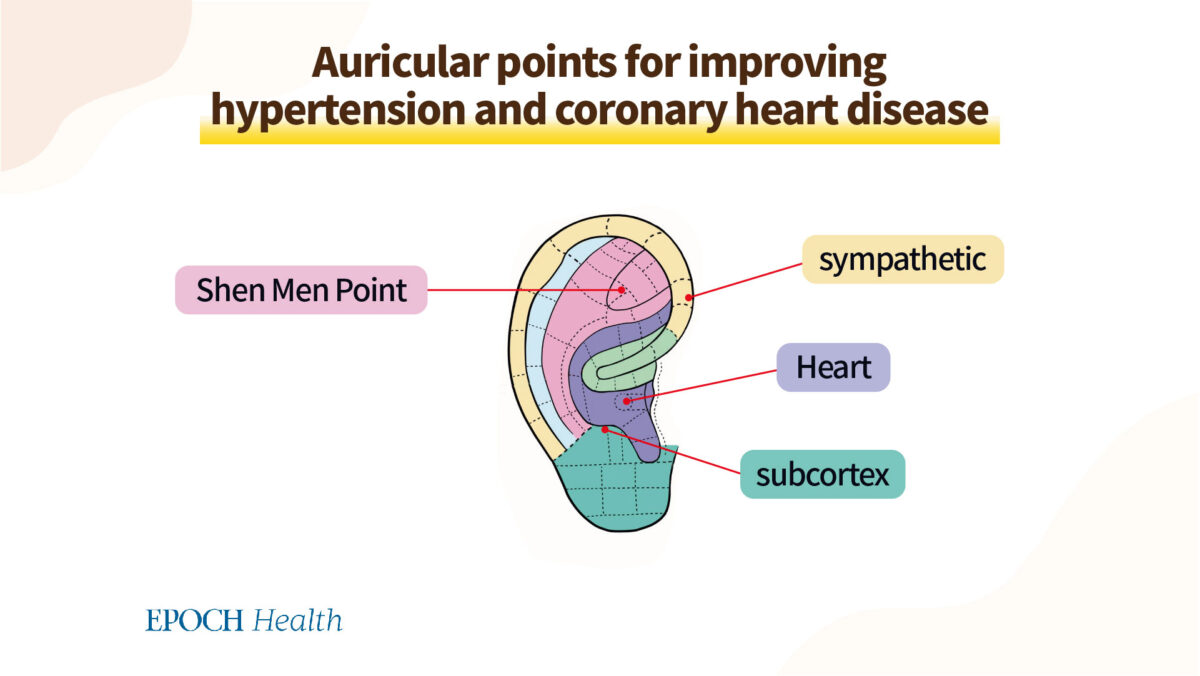
4. The Face
TCM believes that the face represents the heart. And when there is an abnormally dark red or dull face it indicates a serious heart problem. It is especially serious when the dark red color appears on the cheekbones belonging to the small intestine meridian. In this case, in addition to stagnation of qi and blood, it also means that the heart is beating too frequently, and there is chest pain, shortness of breath, and even heart failure in severe cases.
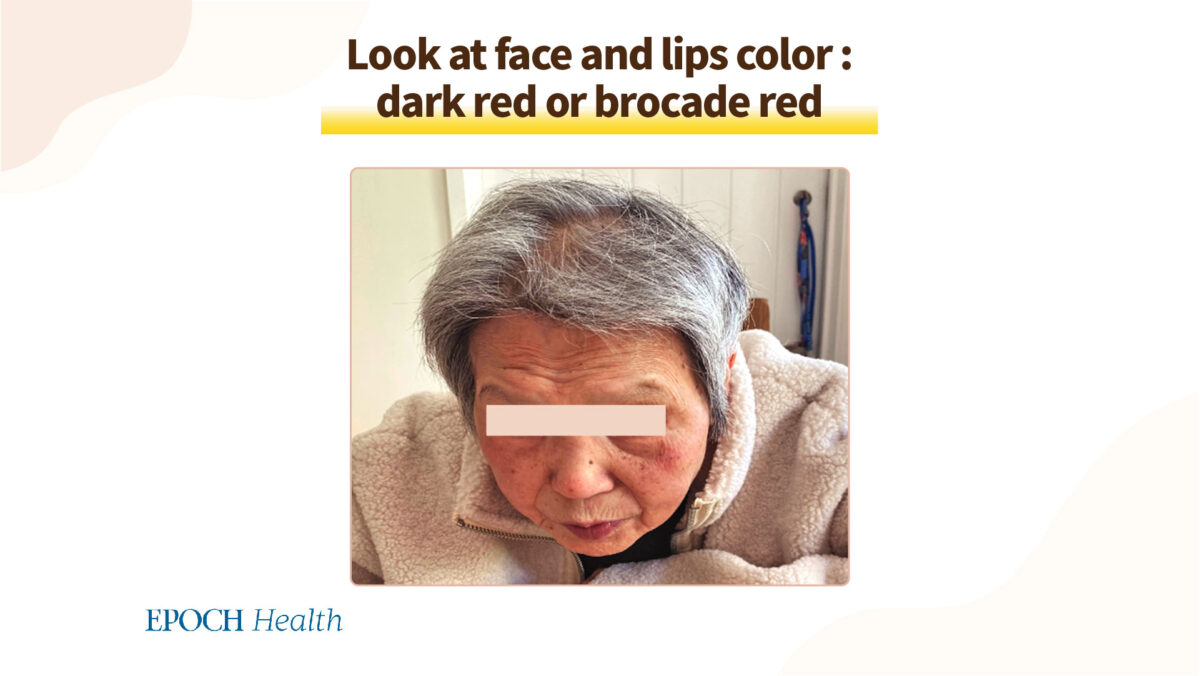
5. Feet Edema
Heart failure will cause the failure of blood to return normally, and from the well-known physical principle that “fluid will follow downward” by nature, symptoms such as edema are likely to appear on the insteps, ankles, and calves.
Risk of Cardiovascular Disease Increases After COVID-19 Infection
After the outbreak of the COVID-19 pandemic, heart rate increase as an after-effect of the pandemic has been confirmed by the medical profession and is called “post-COVID-19 tachycardia syndrome.” Liu Zhongping, director of Taiwan Yupin Clinic and a cardiologist, said frankly in a Facebook post, that he saw more than 20 patients with accelerated heart rate after being diagnosed with COVID-19 in just one week.
Some scientists speculate that infection with COVID-19 induces the body to produce more autoimmune antibodies, and at the same time activates the receptors of the sympathetic nerves, which will lead to an imbalance of the autonomic nerves, and tachycardia.
A study published in the journal Immunology in September 2022 said that after analyzing the autopsy records of deaths after infection with COVID-19 and those infected with H1N1, it found that compared with the H1N1 virus, infection with COVID-19 may lead to more serious diseases, and it can affect many organs, including causing cardiovascular disease.
The study also found that because the protein released by COVID-19 can inhibit a signal transmission protein called “interferon,” the heart tissue cannot activate the anti-viral immune function. This results in the DNA inside the heart tissue of the infected patients being significantly damaged by the virus, causing more severe heart damage as a result.
7 Ways to Prevent Heart Disease
1. Check cholesterol level: If the cholesterol level is too high, it may accumulate in the blood vessels, increasing the risk of heart disease, stroke, and peripheral vascular disease.
2. Measure blood pressure: You can check blood pressure at home, at pharmacies, or at doctor’s practices.
3. Healthy eating: Eating plenty of fresh fruits and vegetables, and choosing healthy meals and snacks, can help to avoid heart disease and its complications. Eating foods low in saturated fat, trans fat, cholesterol, and high in fiber can also help prevent high cholesterol from accumulating. Restricting your intake of salt or sodium can also lower blood pressure.
4. Regular exercise: Exercise can lower cholesterol and blood pressure. In addition to improving physiological functions, it will also produce changes at the cellular and molecular levels. A Spanish animal experiment published in the Journal of Proteome Research in 2014 also confirmed that exercise can change the heart cell powerhouse “mitochondrion” and further improve cardiovascular health.
5. Maintain a healthy body weight: Being overweight or obese increases your risk of heart disease. The body mass index, and sometimes waist and hip measurements can assess a person’s body fat.
6. Limit alcohol intake: Consuming too much alcohol can raise blood pressure. The principle is to take no more than two drinks a day for men, and no more than one for women.
7. Do not smoke: Smoking will greatly increase the risk of heart disease. For smokers, it is advisable to quit smoking as soon as possible.












